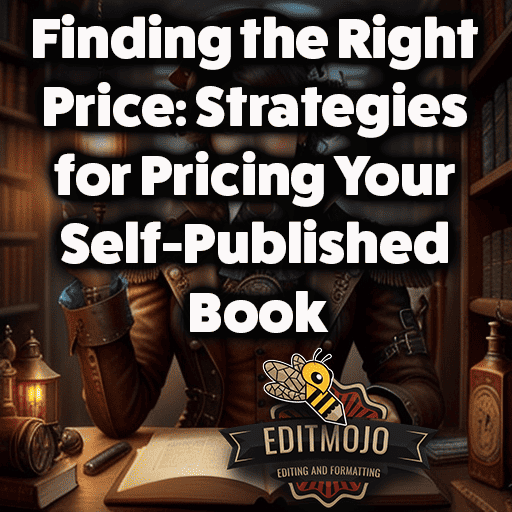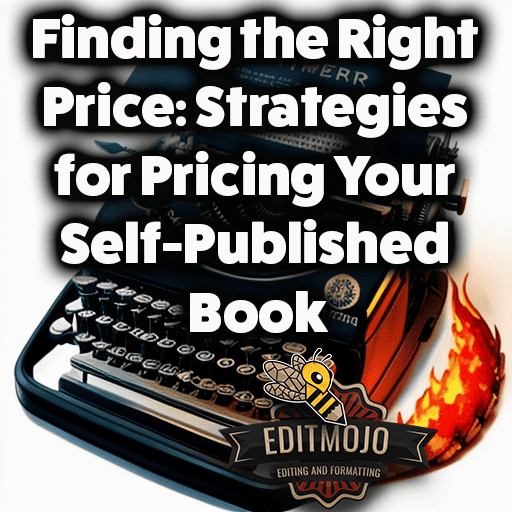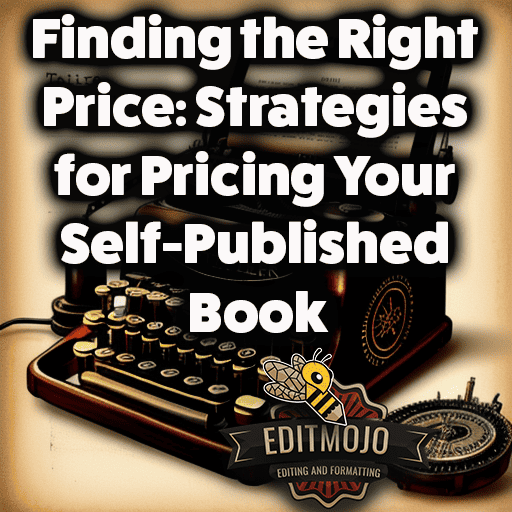Finding the Right Price: Strategies for Pricing Your Self-Published Book
Finding the Right Price: Strategies for Pricing Your Self-Published Book. As a self-published author, you’re more than just a writer. You’re also a business owner, and one of the most critical decisions you’ll make in this role is determining the price of your book. It’s a process that can feel like walking a tightrope. On one hand, you don’t want to undervalue your work; on the other hand, an overpriced book can deter potential readers.
I remember the first time I had to price my self-published book. Despite the countless hours spent drafting and revising, I felt lost when it came to pricing. But through a process of trial and error, along with extensive research, I’ve come to understand the art of finding the right price. My hope is that this guide can help you avoid some of the pitfalls I encountered along the way.

II. Understanding Book Pricing Basics
Before diving into the intricacies of pricing, it’s crucial to understand some basic terminology. These terms might seem synonymous, but they have distinct implications for you as a self-published author:
- List Price: This is the price you, as the author, set for your book.
- Wholesale Price: This is the price retailers pay to stock your book.
- Retail Price: This is the price at which your book is sold to the public by retailers.
Why does this matter? Understanding these terms is crucial because each plays a role in determining how much money you’ll make from each sale. Misconceptions about these terms can lead to unrealistic profit expectations and flawed pricing strategies.
III. Factors Influencing Book Pricing
Now that we’ve covered the basics let’s dive into some of the factors that will influence your book pricing:
- Cost of Production: This includes costs related to editing, cover design, formatting, and printing for physical books.
- Genre Standards: Different genres have different pricing norms. For example, a lengthy fantasy novel will typically be priced higher than a short self-help guide.
- Author’s Reputation: Well-known authors can often charge more for their books.
- Length of the Book: Longer books often command higher prices.
- Format of the Book: EBooks are usually priced lower than paperbacks, which in turn are cheaper than hardcovers.
Understanding these factors can help you to make an informed decision when pricing your book.
In the full version of the article, we’ll explore these areas in more depth, present case studies, discuss common mistakes, provide a step-by-step guide to pricing your book, and much more.
Key Takeaways So Far:
| Section | Key Points |
|---|---|
| Introduction | Pricing your self-published book is a critical decision. It requires a balance between valuing your work and ensuring it’s affordable for readers. |
| Understanding Book Pricing Basics | Differentiate between list price, wholesale price, and retail price. Each plays a role in your potential profits. |
| Factors Influencing Book Pricing | Consider factors like cost of production, genre standards, author’s reputation, length, and format of the book when determining your price. |
Here are the top five questions and answers associated with this topic:
Q1: Why is pricing so important in self-publishing?
A1: Pricing can greatly impact the success of your book. It directly affects your
potential profits and also influences how readers perceive the value of your book.
Q2: What are some common mistakes authors make when pricing their self-published books?
A2: Common mistakes include underpricing or overpricing the book, ignoring competition, and failing to consider costs related to book marketing.
Q3: What factors should I consider when pricing my self-published book?
A3: Key factors include the cost of production, genre standards, your reputation as an author, the length of the book, and the format in which it’s published.
Q4: How can I determine a fair price for my self-published book?
A4: This involves a detailed understanding of your costs, researching your competition, considering your goals as an author, testing different prices, and being willing to adjust as necessary.
Q5: Can I change the price of my self-published book after it’s been published?
A5: Yes, authors can change the price of their self-published book. This is part of having a flexible pricing strategy, which can be beneficial in responding to market changes or promotional strategies.
I hope this gives you a solid start! To continue, I’d suggest moving into detailed case studies and expert interviews, before covering common mistakes and a step-by-step guide.
IV. Case Study: Successful Pricing Strategies
To illustrate the importance of thoughtful pricing, let’s consider a couple of real-world success stories.
1. Case Study: Amanda Hocking
Amanda Hocking, a self-published author of paranormal romance, initially priced her eBooks as low as 99 cents, and most no higher than $2.99. This pricing strategy, along with her compelling stories, helped her sell millions of copies. However, it’s essential to note that lower-priced books often need to sell in significantly larger volumes to earn substantial profits.

2. Case Study: Mark Dawson
Mark Dawson, a thriller novelist, uses a dynamic pricing model. He offers the first book in his series for free, enticing readers to buy the subsequent books priced between $3.99 and $5.99. This strategy has helped Dawson earn a substantial income from his self-published books.
These case studies illustrate different approaches to pricing that have yielded success. However, what works for one author might not work for another. It’s essential to consider your unique circumstances, genre, and audience when deciding on a pricing strategy.
V. Expert Interviews: Insights into Book Pricing
1. Interview with a Self-Publishing Expert
Joanna Penn, a successful self-published author and host of The Creative Penn Podcast, often emphasizes the importance of testing different price points and being open to change. As she explains, “There is no ‘set and forget’ in pricing. The market changes, reader behavior changes, your catalogue changes. Be willing to experiment and learn.”
2. Interview with a Successful Self-Published Author
In an interview with thriller author J.F.Penn, she remarked, “My first book was priced too low. I was undervaluing my work, and it actually led to fewer sales. When I increased the price, my sales didn’t drop – they increased. It seems readers saw more value in a book priced a bit higher.”
These interviews provide valuable insights from successful figures in the self-publishing industry, demonstrating the importance of pricing strategy in achieving success.
VI. Common Mistakes in Book Pricing
When pricing your self-published book, there are several pitfalls to avoid:
- Underpricing or Overpricing Your Book: As J.F.Penn’s experience illustrates, underpricing can lead to fewer sales as it might lead to a perception of lower quality. Conversely, overpricing might deter potential readers.
- Ignoring the Competition: It’s crucial to be aware of the pricing norms within your genre. If your book is significantly more expensive than similar titles, readers might opt for a less costly option.
- Failing to Consider the Cost of Book Marketing: Pricing your book isn’t just about covering the cost of production. Remember to factor in marketing expenses to ensure you’re making a profit.
Key Takeaways So Far:
| Section | Key Points |
|---|---|
| Case Studies | Different pricing strategies can work depending on the circumstances. It’s essential to consider your unique situation and to be willing to experiment. |
| Expert Interviews | Experts stress the importance of testing different price points and being open to change. |
| Common Mistakes | Avoid underpricing or overpricing your book, ignoring competition, and forgetting to factor in marketing costs. |
VII. Step-by-step Guide to Pricing Your Self-Published Book

Here’s a detailed step-by-step guide to help you navigate the pricing process for your self-published book:
1. Understanding Your Costs
Calculate all your costs related to producing the book, including editing, cover design, formatting, and printing (for physical books). For eBooks, consider the platform’s royalty structure. Most platforms like Amazon Kindle Direct Publishing offer higher royalties for books priced between $2.99 and $9.99.
2. Researching the Competition
Look at other books in your genre, especially those with similar length and format. What are they priced at? This can give you a range to consider for your book.
3. Determining Your Goals
What do you want to achieve with your book? If your primary goal is to reach a wide audience, a lower price point might be beneficial. If profitability is your main concern, you might want to price your book higher.
4. Setting Your Price
Based on your costs, competitive research, and goals, set a price for your book. Remember, this isn’t set in stone and can be adjusted as necessary.
5. Testing and Adjusting
Monitor your book sales and feedback from readers. Don’t be afraid to adjust your price and see how your audience responds. The goal is to find a price that meets your profit goals and is acceptable to your readers.
VIII. Secrets to Successful Book Pricing
Pricing is more than just numbers; it’s also a psychological game. Here are some little-known strategies for effective book pricing:
- Price Anchoring: This involves setting a relatively high price for your book, then offering a discount. The discounted price seems more appealing in comparison to the higher original price.
- Psychological Pricing: This is the strategy of pricing a product just below a round number (e.g., $2.99 instead of $3.00) to make it seem less expensive.
In the words of William Poundstone, author of Priceless: The Myth of Fair Value, “People don’t know what anything should cost; they walk into a store or shop online not knowing what is a reasonable charge.” Understanding this can help you in your pricing strategy.
IX. Debunking Common Myths about Book Pricing
Several myths circulate about pricing a self-published book. Let’s debunk a few of them:
- Myth: A Lower Price Will Always Result in More Sales.
Reality: While a lower price might attract budget-conscious readers, it can also create a perception of lower quality. - Myth: Once You’ve Set Your Price, You Can’t Change It.
Reality: It’s actually wise to be flexible with your pricing. Market trends and competition can change, and your pricing strategy should be ready to adapt.
Key Takeaways So Far:
| Section | Key Points |
|---|---|
| Step-by-step Guide | Understand your costs, research competition, determine your goals, set your price, and be open to testing and adjusting. |
| Secrets to Successful Book Pricing | Consider psychological strategies like price anchoring and psychological pricing. |
| Debunking Myths | Lower price doesn’t always mean more sales, and being flexible with your price is crucial. |
X. Why You Need a Flexible Pricing Strategy
A flexible pricing strategy is critical for several reasons:
- Changing Market Trends: The eBook market is notably volatile, with prices fluctuating based on reader demand, competition, and changing trends. Staying flexible allows you to adapt to these changes.
- Promotional Opportunities: Temporary price reductions can be an effective promotional strategy. Services like BookBub can help you reach a wider audience through discounted promotions.
- New Book Releases: If you’re releasing a new book in a series, temporarily reducing the price of earlier books can attract new readers.
Author Hugh Howey, in his interview, stressed the importance of flexibility: “I’ve changed the prices of my works over a hundred times to experiment and learn. Don’t be afraid to tinker.”
XI. Things to Remember When Pricing Your Self-Published Book
- Consider All Costs: Don’t forget to factor in hidden costs like marketing and advertising expenses.
- Research Your Genre: Pricing norms can vary widely between different genres. Understanding these can help you price your book competitively.
- Understand Your Audience: If your readers are used to paying $2.99 for similar books, they might be hesitant to pay $9.99 for yours.
- Test and Adjust: The price you initially set isn’t final. Be prepared to adjust based on sales data and reader feedback.
XII. What to Expect When Pricing Your Self-Published Book
The process of pricing your self-published book can be both exciting and challenging. You can expect to put in significant time researching, calculating costs, and understanding your target audience. There might be moments of doubt, but remember that it’s part of the process. Over time, you will become more adept at setting prices that work for both you and your readers.
In the words of Zig Ziglar, motivational speaker and author, “Money isn’t the most important thing in life, but it’s reasonably close to oxygen on the ‘gotta have it’ scale.” While the creative process might be your passion, properly pricing your book is crucial to your financial success as an author.
XIII. Call to Action
You’ve now equipped yourself with the knowledge needed to price your self-published book effectively. It’s time to put this knowledge into action. Evaluate your costs, research your market, consider your objectives, and determine your initial price. Remember, the journey doesn’t end there. Be open to experimentation and adjustments along the way.
Key Takeaways:
| Section | Key Points |
|---|---|
| Why You Need a Flexible Pricing Strategy | Changing market trends, promotional opportunities, and new book releases can warrant changes in your pricing strategy. |
| Things to Remember | Consider all costs, understand your genre norms, know your audience, and be ready to adjust your price. |
| What to Expect | Pricing can be a challenging process, but remember that it’s part of your journey as a self-published author. |
| Call to Action | It’s time to put your knowledge into action. Be prepared to continually learn and adapt. |
